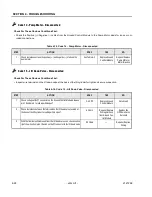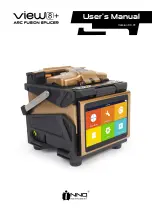
SECTION 5 -
SECTION 5 - MAST COMPONENTS
MAST COMPONENTS
5-10
5-10
– JLG Lift –
– JLG Lift –
3121228
3121228
Lift Cylinder Component Inspection
Lift Cylinder Component Inspection
Cylinder Rod
Cylinder Rod
There should be no scratches or pits deep enough to
There should be no scratches or pits deep enough to
catch the fingernail. Pits that go to the base metal are
catch the fingernail. Pits that go to the base metal are
unacceptable. Scratches that catch the fingernail but are
unacceptable. Scratches that catch the fingernail but are
not to the base metal, less than
not to the base metal, less than 0.5 inch long and primarily
0.5 inch long and primarily
in the circumferential direction are acceptable provided
in the circumferential direction are acceptable provided
they cannot cut the rod seal.
they cannot cut the rod seal. Chrome should be present
Chrome should be present
over the entire surface of the rod and the lack thereof is
over the entire surface of the rod and the lack thereof is
unacceptable. In the event that an unacceptable condition
unacceptable. In the event that an unacceptable condition
occurs, the rod should be
occurs, the rod should be repaired or replaced.
repaired or replaced.
Cylinder Head
Cylinder Head
Visually inspect the inside bore for
Visually inspect the inside bore for scratches or polishing.
scratches or polishing.
Deep scratches are unacceptable. Polishing indicates
Deep scratches are unacceptable. Polishing indicates
uneven loading and when this occurs,
uneven loading and when this occurs, the bore should be
the bore should be
checked for
checked for out-of-ro
out-of-roundness. If
undness. If out-of-roun
out-of-roundness
dness
exceeds 0.007", this is unacceptable. Check the
exceeds 0.007", this is unacceptable. Check the condition
condition
of the dynamic seals (wiper, rod seals) looking particularly
of the dynamic seals (wiper, rod seals) looking particularly
for metallic particles embedded in the seal surface. It is
for metallic particles embedded in the seal surface. It is
normal to cut the static seal
normal to cut the static seal on the retaining ring groove
on the retaining ring groove
upon disassembly. Remove the rod seal, static o-ring and
upon disassembly. Remove the rod seal, static o-ring and
backup and rod wiper. Damage to the seal grooves, par-
backup and rod wiper. Damage to the seal grooves, par-
ticularly on the sealing surfaces, is unacceptable. In the
ticularly on the sealing surfaces, is unacceptable. In the
event that an
event that an unacceptab
unacceptable condition occurs, the head
le condition occurs, the head
should be replaced.
should be replaced.
Piston
Piston
Visually inspect the outside surface for scratches or pol-
Visually inspect the outside surface for scratches or pol-
ishing. Deep scratches
ishing. Deep scratches are unacceptable. Polishing indi-
are unacceptable. Polishing indi-
cates uneven loading and when this occurs, the diameter
cates uneven loading and when this occurs, the diameter
should be checked for out-of-roundness. If out-of-round-
should be checked for out-of-roundness. If out-of-round-
ness exceeds 0.007", this is
ness exceeds 0.007", this is unacceptable. Check the con-
unacceptable. Check the con-
dition of the dynamic seals and bearings looking
dition of the dynamic seals and bearings looking
particularly for metallic particles embedded in the bearing
particularly for metallic particles embedded in the bearing
and in the piston seal surface. Remove the seals and
and in the piston seal surface. Remove the seals and
bearings. Damage to the seal grooves, particularly on the
bearings. Damage to the seal grooves, particularly on the
sealing surfaces, is unacceptable. In the event that an
sealing surfaces, is unacceptable. In the event that an
unacceptable condition occurs, the piston should be
unacceptable condition occurs, the piston should be
replaced.
replaced.
Tube Assembly
Tube Assembly
Visually inspect the inside bore for scratches and pits.
Visually inspect the inside bore for scratches and pits.
There should be no scratches or pits deep enough to
There should be no scratches or pits deep enough to
catch the fingernail. Scratches that catch the fingernail but
catch the fingernail. Scratches that catch the fingernail but
are less than 0.5 inch long and primarily in the circumfer-
are less than 0.5 inch long and primarily in the circumfer-
ential direction are acceptable provided they cannot cut
ential direction are acceptable provided they cannot cut
the piston seal. The roughness of the bore should be
the piston seal. The roughness of the bore should be
between 10 and 20
between 10 and 20
μ
μ
inches RMS.
inches RMS. Significant variati
Significant variation
on
(greater than 8
(greater than 8
μ
μ
inches difference) are
inches difference) are unacceptab
unacceptable. In
le. In
the event that an
the event that an unacceptable condition occurs, the tube
unacceptable condition occurs, the tube
assembly should be repaired or re
assembly should be repaired or re placed.
placed.
Cylinder Assembly
Cylinder Assembly
(See
(See Figure 5-3.
Figure 5-3. )
)
1.
1. Rinse
Rinse the in
the inside
side of th
of the tube
e tube with h
with hydrau
ydraulic fl
lic fluid a
uid and
nd
allow to drain. A high-pressure rinse followed by a
allow to drain. A high-pressure rinse followed by a
wipe with a lint-free rag is preferable. Clean all inter-
wipe with a lint-free rag is preferable. Clean all inter-
nal components of any foreign material.
nal components of any foreign material.
2.
2. Lubri
Lubricate
cate the h
the head a
ead and al
nd all sea
l seals wit
ls with hy
h hydraul
draulic fl
ic fluid
uid
prior to installation. Install the seal, wiper, o-ring,
prior to installation. Install the seal, wiper, o-ring,
back-up ring, and retraining ring to the cylinder
back-up ring, and retraining ring to the cylinder
head.
head.
3.
3. Lubri
Lubricate
cate the
the pisto
piston an
n and a
d all c
ll compon
omponents
ents with
with
hydraulic fluid. Install the seal and wear ring to the
hydraulic fluid. Install the seal and wear ring to the
piston.
piston.
NOTE:
NOTE:
Re-check that seals are not twisted or pinched and
Re-check that seals are not twisted or pinched and
are properly seated.
are properly seated.
4.
4. Place
Place the ro
the rod on a
d on a clean t
clean table.
able. Instal
Install the
l the stati
static pis
c pis--
ton o-ring seal into the groove on the piston end of
ton o-ring seal into the groove on the piston end of
the rod.
the rod.
5.
5. Insta
Install th
ll the head
e head foll
followed b
owed by the
y the pist
piston on
on onto th
to the rod
e rod
noting the proper orientation of each component.
noting the proper orientation of each component.
Torque the piston nut to 100-120 ft. lbs.
Torque the piston nut to 100-120 ft. lbs.
6.
6. When
When the ro
the rod ass
d assembly
embly is re
is ready t
ady to be
o be insta
installed
lled into
into
the tube, liberally apply an
the tube, liberally apply an anti-seize lubricant to the
anti-seize lubricant to the
cylinder head surface which slides into the cylinder
cylinder head surface which slides into the cylinder
tube.
tube.
7.
7. Next d
Next dip th
ip the enti
e entire rod
re rod assemb
assembly in
ly into hy
to hydraul
draulic fl
ic fluid
uid
and stuff this assembly into the tube. Watch the
and stuff this assembly into the tube. Watch the
seals as they pass over the rod port
seals as they pass over the rod port
(if visible)
(if visible)
to be
to be
sure they are not nicked or cut.
sure they are not nicked or cut.
8.
8. Insta
Install the h
ll the head un
ead until th
til the retai
e retaining r
ning ring s
ing seats in
eats in it’s
it’s
groove.
groove.















































